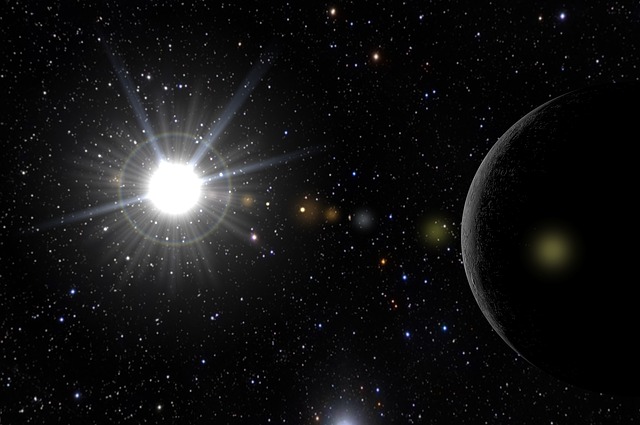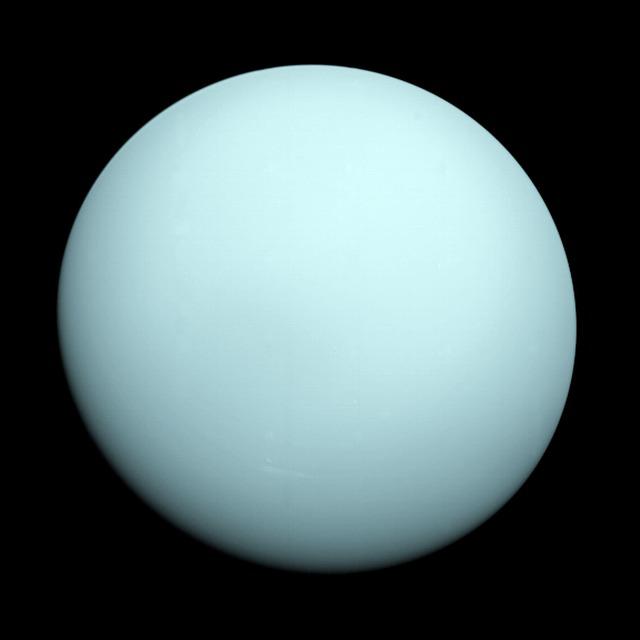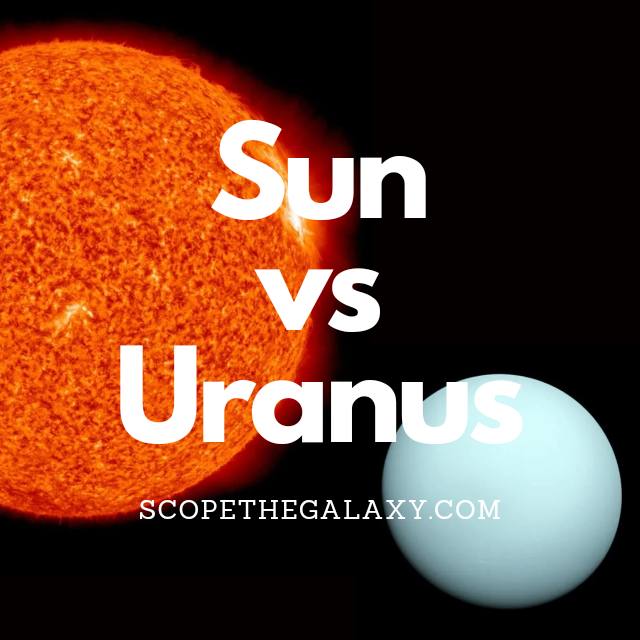*This post may contain affiliate links. This means we may make a commission if you purchase an item using one of our links*
The main differences between the Sun and Uranus is that the former is a yellow main sequence star at the center of the solar system that Uranus orbits around and produces energy for the entities around it whilst Uranus is an ice giant that is the 7th farthest planet from the Sun that has spins on a 98 degree axial tilt, has 27 moons and is far colder than the Sun.
There are a plethora of other differences between these two entities as they are very different celestial objects after all so, continue reading if you want a more thorough breakdown of the similarities and differences between both the Sun and Uranus.
What Is The Sun?
Table of Contents

The Sun is the bright, celestial entity at the center of our solar system and is also a star that falls under the G type main sequence star bracket (also called a yellow dwarfs), all of which are medium sized stars that tend to be around 0.84 – 1.15 solar masses.
Our Sun is 1 solar mass, making it a medium sized medium star. It’s also on the brighter side for a yellow dwarf, the color that it emits is white as opposed to the slightly yellow that less luminous yellow dwarfs would be.
Of course we still see the Sun as yellow or even red on Earth but, the reason for this significant color shift is because our atmosphere scatters and breaks up the photons that reach us, ultimately changing the true color of the light rays from white to the yellow, orange or red we see in our day to day.
As it is a star, the Sun will actively convert the hydrogen elements at its core into helium, through a process called nuclear fusion.
Nuclear fusion is the reason why it generates light and produces the energy we receive, helping us power machinery, technology, grow crops so on and so forth.
The process of nuclear fusion also affects how hot our star burns, allowing the sun to hit temperatures around 6000°C on a daily basis. This will be the case for another 4.5 – 5 billion years until it’s unable to convert hydrogen into helium.
Once hydrogen cannot be converted, an imbalance between the inward and outward forces keeping the Sun together will occur, causing an imbalance which would result in our Sun bloating up many many times its current size.
When this happens it will enter its red giant phase, where it’ll be around 256 times larger than it is now.
This phase will last for around a billion years until it sheds it mass through a process called planetary nebula, leaving behind only a dead white dwarf remnant.
What Is The Planet Uranus?

Uranus is the 7th farthest planet from the Sun and the 3rd largest planet in our solar system, coming in at a diameter of 50,724 km. This means that roughly 63 Earth’s could fit inside this ice giant.
In regards to why this cyan blue planet is referred to as an ice giant, it’s down to it’s composition. Uranus is made mostly of methane, ammonia and water with its atmosphere mostly consisting of hydrogen and helium, much like the Sun, and the other giant planets in our solar system.
Due to its distance from the Sun, it takes Uranus 84 years to complete one orbit around the Sun, whereas it’s axial rotation is much faster than even our Earth at 17 hours per rotation.
As a result of its distance from the Sun, ice based composition and faster rotation levels, Uranus is far from an ideal place to live in or even have the potential to support life.
Its base temperature is generally a chilling -190 to -200 degrees Celsius and its rocky core, although hot, is still on the cooler side for a large planet sitting around the 5,000 degrees Celsius range.
The planets winds are also very fast often hitting 900 km/h, which is roughly twice that of Earth’s most powerful turbulent wind speeds.
In regards to the moons present surrounding this cyan planet, we’ve discovered 27 small moons orbiting it. Furthermore, it has 13 rings surrounding it which also means Uranus has the most abundant collection of rings surrounding in our solar system, which is even more than Saturn.
One of the Uranus’ most unique features would include the manner in which it rotates around its axis. As opposed to the slightly angled rotation that the likes of Earth, Saturn and most other planets display, Uranus’ axis is positioned at a 98 degree angle.
What this means is this ice giant completes an axial rotation on its side as opposed to the relatively up straight positioning of most of the other planets in our solar system.
Similarities Between The Sun And Uranus
Uranus and the Sun don’t have too many commonalities but there are a few that can be observed. Firstly, both are composed of hydrogen and helium, both have a core significantly hotter than their surface, both are part of the same solar system and lastly, both are spherical in shape.
Other than these core similarities, you’ll definitely notice a lot more differences between the two if you dig deeper into the subject.
Differences Between The Sun And Uranus
In regards to the differences between the Sun and Uranus, they include the following.
- Although Uranus has a number of moons orbiting it meaning its gravitational pull is decently strong, the Sun’s pull is clearly much stronger as a whole solar system orbits it.
- Uranus orbits the Sun whilst the Sun does not orbit anything
- The Sun is obviously much hotter where its surface temperature is around 6,000 degrees Celsius whereas Uranus is around -190 to -200. As for the core Uranus is hotter at around 5,000 degrees Celsius but, the Sun is far hotter at 15 million degrees Celsius.
- The Sun has solar winds on its surface that exceed 1.4 million km/h in speed whereas Uranus’ wind speeds are only 900 km/h.
- The Sun is a yellow dwarf that is estimated to die within 10 billion years of its birth just before it becomes a white dwarf whilst Uranus doesn’t have a set lifespan.
- The Sun can create its own energy and light source via nuclear fusion whilst Uranus isn’t known to create its own light and obviously far less energy too.
- Uranus has an axial tilt at 98 degrees whilst the Sun’s axial tilt is 7.25 degrees.
- The Sun completes one orbit around its axis in 27 days whilst Uranus completes a rotation in 17 hours.
- The Sun is far bigger than Uranus with a diameter of 1.39 million km in comparison to Uranus’ 50,724 km diameter.
- In regards to mass, The Sun is clearly far heavier. Uranus is around 8.681 × 10^25 kg whereas the sun is 1.989 × 10^30 kg
- Uranus is an Ice giant whilst the Sun is yellow dwarf so, essentially a huge burning mass that supports the life around it.
- Uranus is able to create water whereas the Sun cannot.
- Uranus has a magnetic field strength of 0.23 gauss whereas the Sun’s magnetic field strength is 1 gauss.
Summary
Uranus and the Sun fall under completely different brackets for celestial objects, where one is a star that supports life around it and the other is an ice based planet that is far less practical but, is a very interesting entity to observe.
From the temperature, size, influence on its surrounding and even their composition, both of these celestial bodies are very different from one another, even if they can are part of the same solar system.

